Cohen I.M., Kundu P.K. Fluid Mechanics
Подождите немного. Документ загружается.

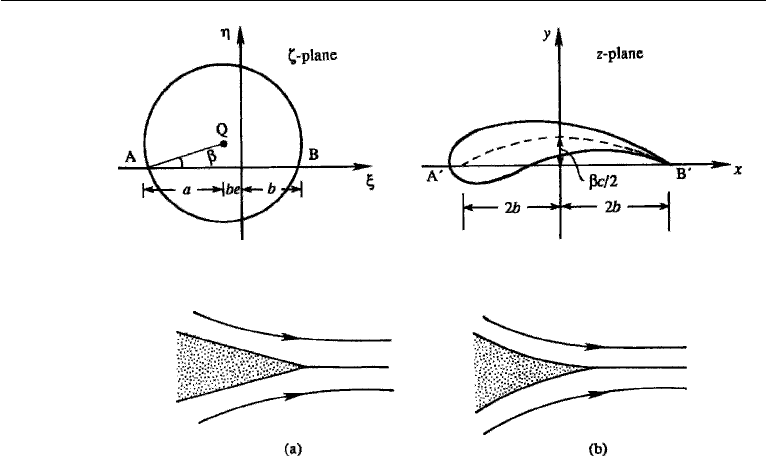
692 Aerodynamics
Figure 15.15 Transformation of a circle into a cambered airfoil.
Figure 15.16 Shapes of the trailing edge: (a) trailing edge with finite angle; and (b) cusped trailing edge.
Here t
max
is the maximum thickness, which is reached nearly at the quarter chord
position x =−b. The “camber,” defined in Figure 15.6, is indicated in Figure 15.15.
Such airfoils generated from the Zhukhovsky transformation are called
Zhukhovsky airfoils. They have the property that the trailing edge is a cusp, which
means that the upper and lower surfaces are tangent to each other at the trailing
edge. Without the Kutta condition, the trailing edge is a point of infinite velocity,
as discussed in Section 5. If the trailing edge angle is nonzero (Figure 15.16a), the
coincidence of the stagnation point with the point of infinite velocity still makes the
trailing edge a stagnation point, because of the following argument: The fluid velocity
on the upper and lower surfaces is parallel to its respective surface. At the trailing
edge this leads to normal velocities in different directions, which cannot be possible.
The velocities on both sides of the airfoil must therefore be zero at the trailing edge.
This is not true for the cusped trailing edge of a Zhukhovsky airfoil (Figure 15.16b).
In that case the tangents to the upper and lower surfaces coincide at the trailing edge,
and the fluid leaves the trailing edge smoothly. The trailing edge for the Zhukhovsky
airfoil is simply an ordinary point where the velocity is neither zero nor infinite.
8. Lift of Zhukhovsky Airfoil
The preceding section has shown how a circle is transformed into an airfoil with
the help of the Zhukhovsky transformation. We are now going to determine certain
flow properties of such an airfoil. Consider flow around the circle with clockwise
circulation in the ζ -plane, in which the approach velocity is inclined at an angle α
with the ξ -axis (Figure 15.17). The corresponding pattern in the z-plane is the flow
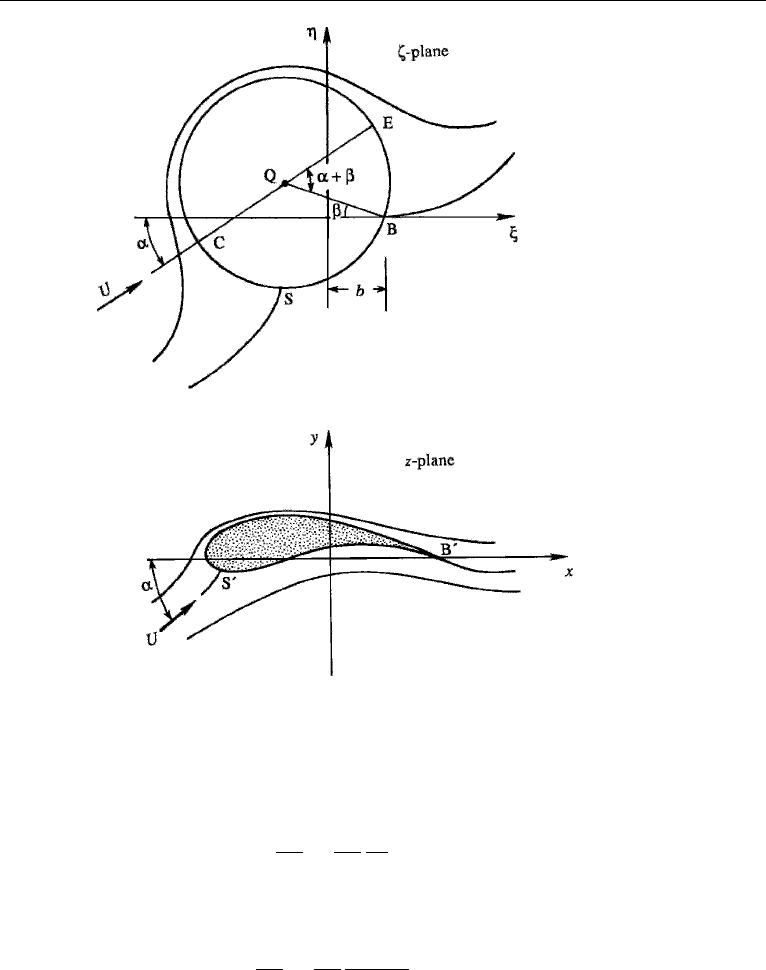
8. Lift of Zhukhovsky Airfoil 693
Figure 15.17 Transformation of flow around a circle into flow around an airfoil.
around an airfoil with circulation and angle of attack α. It can be shown that the
circulation does not change during a conformal transformation. If w = φ + iψ is the
complex potential, then the velocities in the two planes are related by
dw
dz
=
dw
dζ
dζ
dz
.
Using the Zhukhovsky transformation (15.3), this becomes
dw
dz
=
dw
dζ
ζ
2
ζ
2
− b
2
. (15.9)
Here dw/dz = u − iv is the complex velocity in the z-plane, and dw/dζ is the
complex velocity in the ζ -plane. Equation (15.9) shows that the velocities in the two
planes become equal as ζ →∞, which means that the free-stream velocities are
inclined at the same angle α in the two planes.

694 Aerodynamics
Point B with coordinates (b, 0) in the ζ -plane is transformed into the trailing
edge B
of the airfoil. Because ζ
2
−b
2
vanishes there, it follows from equation (15.9)
that the velocity at the trailing edge will in general be infinite. If, however, we arrange
that B is a stagnation point in the ζ -plane at which dw/dζ = 0, then dw/dz at the
trailing edge will have the 0/0 form. Our discussion of Figure 15.16b has shown that
this will in fact result in a finite velocity at B
.
From equation (6.39), the tangential velocity at the surface of the cylinder is
given by
u
θ
=−2U sin θ −
2πa
, (15.10)
where θ is measured from the diameter CQE. At point B, we have u
θ
= 0 and
θ =−(α + β). Therefore equation (15.10) gives
= 4πUa sin(α + β),
(15.11)
which is the clockwise circulation required by the Kutta condition. It shows that the
circulation around an airfoil depends on the speed U , the chord length c(4a), the
angle of attack α, and the camber/chord ratio β/2. The coefficient of lift is
C
L
=
L
(1/2)ρU
2
c
2π(α + β),
(15.12)
where we have used 4a c, L = ρU, and sin(α + β) (α + β) for small angles
of attack. Equation (15.12) shows that the lift can be increased by adding a certain
amount of camber. The lift is zero at a negative angle of attack α =−β, so that the
angle (α +β) can be called the “absolute” angle of attack. The fact that the lift of an
airfoil is proportional to the angle of attack is important, as it suggests that the pilot
can control the lift simply by adjusting the attitude of the airfoil.
A comparison of the theoretical lift equation (15.12) with typical experimental
results on a Zhukhovsky airfoil is shown in Figure 15.18. The small disagreement
can be attributed to the finite thickness of the boundary layer changing the effective
shape of the airfoil. The sudden drop of the lift at (α + β) 20
◦
is due to a severe
boundary layer separation, at which point the airfoil is said to stall. This is discussed
in Section 12.
Zhukhovsky airfoils are not practical for two basic reasons. First, they demand a
cusped trailing edge, which cannot be practically constructed or maintained. Second,
the camber line in a Zhukhovsky airfoil is nearly a circular arc, and therefore the
maximum camber lies close to the center of the chord. However, a maximum camber
within the forward portion of the chord is usually preferred so as to obtain a desirable
pressure distribution. To get around these difficulties, other families of airfoils have
been generated from circles by means of more complicated transformations. Never-
theless, the results for a Zhukhovsky airfoil given here have considerable application
as reference values.
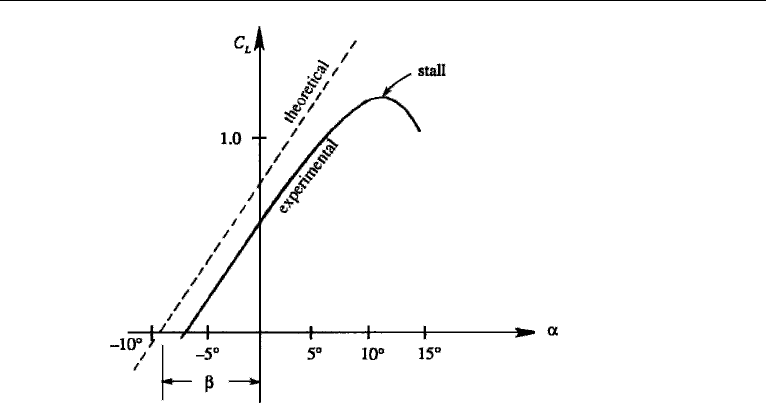
9. Wing of Finite Span 695
Figure 15.18 Comparison of theoretical and experimental lift coefficients for a cambered Zhukhovsky
airfoil.
9. Wing of Finite Span
So far we have considered only two-dimensional flows around wings of infinite span.
We shall now consider wings of finite span and examine how the lift and drag are
modified. Figure 15.19 shows a schematic view of a wing, looking downstream from
the aircraft. As the pressure on the lower surface of the wing is greater than that on
the upper surface, air flows around the wing tips from the lower into the upper side.
Therefore, there is a spanwise component of velocity toward the wing tip on the under-
side of the wing and toward the center on the upper side, as shown by the streamlines
in Figure 15.20a. The spanwise momentum continues as the fluid goes over the wing
and into the wake downstream of the trailing edge. On the stream surface extending
downstream from the wing, therefore, the lateral component of the flow is outward
(toward the wing tips) on the underside and inward on the upper side. On this surface,
then, there is vorticity with axes oriented in the streamwise direction. The vortices
have opposite signs on the two sides of the central axis OQ. The streamwise vortex
filaments downstream of the wing are called trailing vortices, which form a vortex
sheet (Figure 15.20b). As discussed in Chapter 5, Section 9, a vortex sheet is com-
posed of closely spaced vortex filaments and generates a discontinuity in tangential
velocity.
Downstream of the wing the vortex sheet rolls up into two distinct vortices, which
are called tip or trailing vortices. The circulation around each of the tip vortices is
equal to
0
, the circulation at the center of the wing (Figure 15.21). The existence
of the tip vortices becomes visually evident when an aircraft flies in humid air. The
decreased pressure (due to the high velocity) and temperature in the core of the tip
vortices often cause atmospheric moisture to condense into droplets, which are seen
in the form of vapor trails extending for kilometers across the sky.
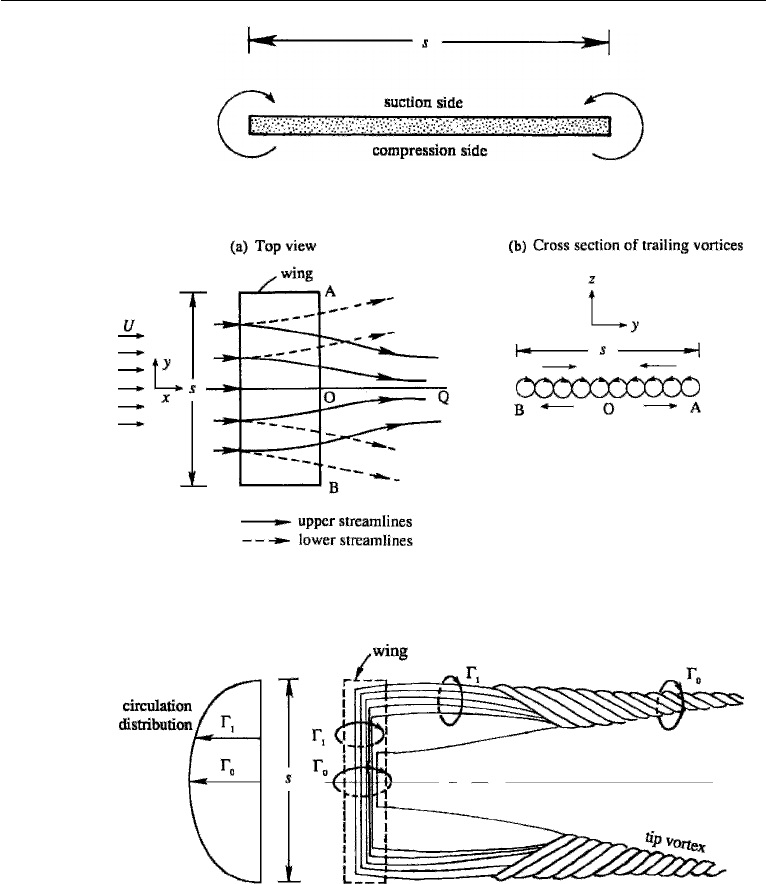
696 Aerodynamics
Figure 15.19 Flow around wind tips.
Figure 15.20 Flow over a wing of finite span: (a) top view of streamline patterns on the upper and lower
surfaces of the wing; and (b) cross section of trailing vortices behind the wing.
Figure 15.21 Rolling up of trailing vortices to form tip vortices.
One of Helmholtz’s vortex theorems states that a vortex filament cannot end in
the fluid, but must either end at a solid surface or form a closed loop or “vortex ring.”
In the case of the finite wing, the tip vortices start at the wing and are joined together
at the other end by the starting vortices. The starting vortices are left behind at the
point where the aircraft took off, and some of them may be left where the angle of
attack was last changed. In any case, they are usually so far behind the wing that

10. Lifting Line Theory of Prandtl and Lanchester 697
their effect on the wing may be neglected, and the tip vortices may be regarded as
extending to an infinite distance behind the wing.
As the aircraft proceeds the tip vortices get longer, which means that kinetic
energy is being constantly supplied to generate the vortices. It follows that an addi-
tional drag force is experienced by a wing of finite span. This is called the induced
drag, which is explored in the following section.
10. Lifting Line Theory of Prandtl and Lanchester
In this section we shall formalize the concepts presented in the preceding section and
derive an expression for the lift and induced drag of a wing of finite span. The basic
assumption of the theory is that the value of the aspect ratio span/chord is large,
so that the flow around a section is approximately two dimensional. Although a
formal mathematical account of the theory was first published by Prandtl, many of
the important underlying ideas were first conceived by Lanchester. The historical
controversy regarding the credit for the theory is noted at the end of the section.
Bound and Trailing Vortices
It is known that a vortex, like an airfoil, experiences a lift force when placed in a
uniform stream. In fact, the disturbance created by an airfoil in a uniform stream is in
many ways similar to that created by a vortex filament. It therefore follows that a wing
can be replaced by a vortex, with its axis parallel to the wing span. This hypothetical
vortex filament replacing the wing is called the bound vortex, “bound” signifying that
it moves with the wing. We say that the bound vortex is located on a lifting line, which
is the core of the wing. Recall the discussion in Section 7 where the camber line was
replaced by a vortex sheet in thin airfoil theory. This sheet may be regarded as the
bound vorticity. According to one of the Helmholtz theorems (Chapter 5, Section 4),
a vortex cannot begin or end in the fluid; it must end at a wall or form a closed loop.
The bound vortex therefore bends downstream and forms the trailing vortices.
The strength of the circulation around the wing varies along the span, being
maximum at the center and zero at the wing tips. A relation can be derived between
the distribution of circulation along the wing span and the strength of the trailing
vortex filaments. Suppose that the clockwise circulation of the bound vortex changes
from to − d at a certain point (Figure 15.22a). Then another vortex AC of
strength d must emerge from the location of the change. In fact, the strength and
sign of the circulation around AC is such that, when AC is folded back onto AB, the
circulation is uniform along the composite vortex tube. (Recall the vortex theorem of
Helmholtz, which says that the strength of a vortex tube is constant along its length.)
Now consider the circulation distribution (y) over a wing (Figure 15.22b). The
change in circulation in length dy is d, which is a decrease if dy > 0. It follows
that the magnitude of the trailing vortex filament of width dy is
−
d
dy
dy,
The trailing vortices will be stronger near the wing tips where d/dy is the largest.
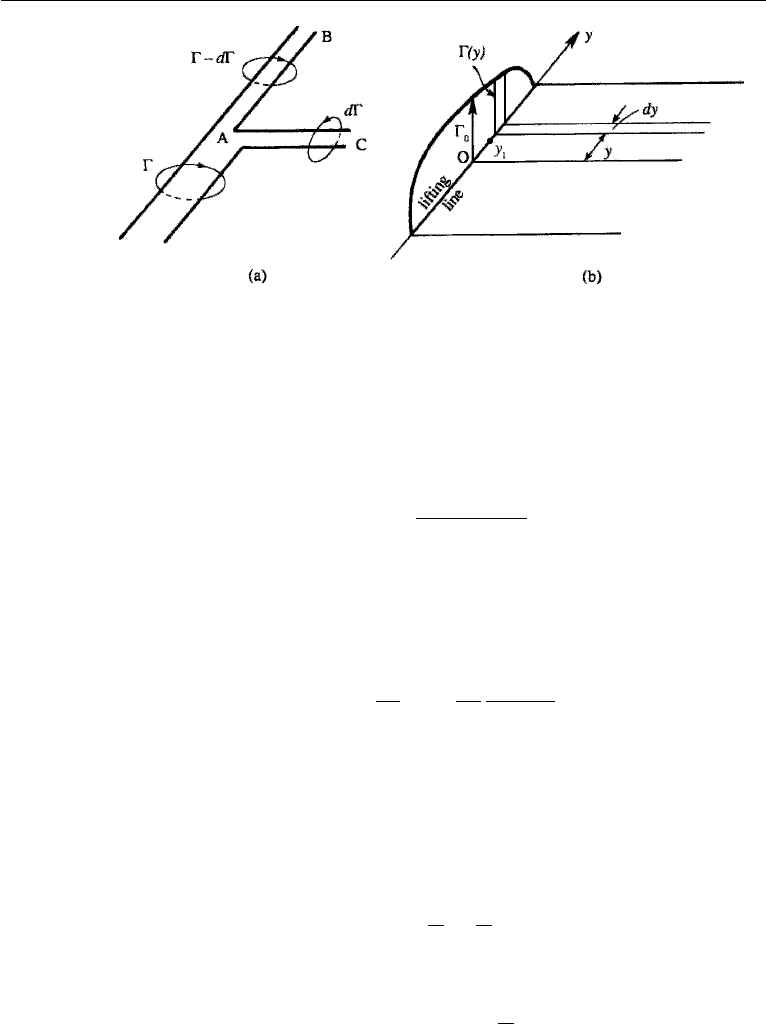
698 Aerodynamics
Figure 15.22 Lifting line theory: (a) change of vortex strength; and (b) nomenclature.
Downwash
Let us determine the velocity induced at a point y
1
on the lifting line by the trailing
vortex sheet. Consider a semi-infinite trailing vortex filament, whose one end is at the
lifting line. Such a vortex of width dy, having a strength −(d/dy) dy, will induce
a downward velocity of magnitude
dw(y
1
) =
−(d/dy) dy
4π(y − y
1
)
.
Note that this is half the velocity induced by an infinitely long vortex, which equals
(circulation)/(2πr) where r is the distance from the axis of the vortex. The bound
vortex makes no contribution to the velocity induced at the lifting line itself.
The total downward velocity at y
1
due to the entire vortex sheet is therefore
w(y
1
) =
1
4π
s/2
−s/2
d
dy
dy
(y
1
− y)
, (15.13)
which is called the downwash at y
1
on the lifting line of the wing. The vortex sheet
also induces a smaller downward velocity in front of the airfoil and a larger one behind
the airfoil (Figure 15.23).
The effective incident flow on any element of the wing is the resultant of U and w
(Figure 15.24). The downwash therefore changes the attitude of the airfoil, decreasing
the “geometrical angle of attack” α by the angle
ε = tan
w
U
w
U
,
so that the effective angle of attack is
α
e
= α − ε = α −
w
U
. (15.14)
Because the aspect ratio is assumed large, ε is small. Each element dy of the finite
wing may then be assumed to act as though it is an isolated two-dimensional section
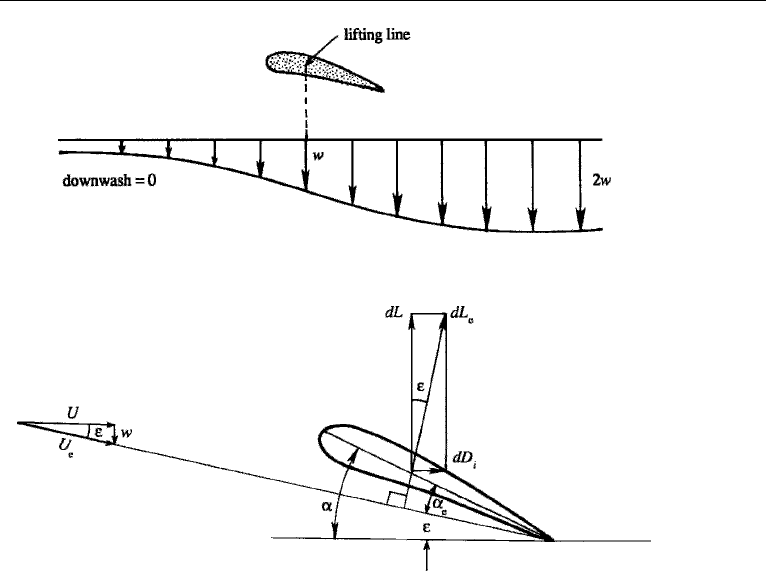
10. Lifting Line Theory of Prandtl and Lanchester 699
Figure 15.23 Variation of downwash ahead of and behind an airfoil.
Figure 15.24 Lift and induced drag on a wing element dy.
set in a stream of uniform velocity U
e
, at an angle of attack α
e
. According to the
Kutta–Zhukhovsky lift theorem, a circulation superimposed on the actual resultant
velocity U
e
generates an elementary aerodynamic force dL
e
= ρU
e
dy, which acts
normal to U
e
. This force may be resolved into two components, the conventional
lift force dL normal to the direction of flight and a component dD
i
parallel to the
direction of flight (Figure 15.24). Therefore
dL = dL
e
cos ε = ρU
e
dycos ε ρU dy,
dD
i
= dL
e
sin ε = ρU
e
dysin ε ρw dy.
In general w, , U
e
, ε, and α
e
are all functions of y, so that for the entire wing
L =
s/2
−s/2
ρU dy,
D
i
=
s/2
−s/2
ρw dy.
(15.15)
These expressions have a simple interpretation: Whereas the interaction of U and
generates L, which acts normal to U, the interaction of w and generates D
i
, which
acts normal to w.

700 Aerodynamics
Induced Drag
The drag force D
i
induced by the trailing vortices is called the induced drag, which is
zero for an airfoil of infinite span. It arises because a wing of finite span continuously
creates trailing vortices and the rate of generation of the kinetic energy of the vortices
must equal the rate of work done against the induced drag, namely D
i
U. For this reason
the induced drag is also known as the vortex drag. It is analogous to the wave drag
experienced by a ship, which continuously radiates gravity waves during its motion.
As we shall see, the induced drag is the largest part of the total drag experienced by
an airfoil.
A basic reason why there must be a downward velocity behind the wing is the
following: The fluid exerts an upward lift force on the wing, and therefore the wing
exerts a downward force on the fluid. The fluid must therefore constantly gain down-
ward momentum as it goes past the wing. (See the photograph of the spinning baseball
(Figure 10.27), which exerts an upward force on the fluid.)
For a given (y), it is apparent that w(y) can be determined from equation (15.13)
and D
i
can then be determined from equation (15.15). However, (y) itself depends
on the distribution of w(y), essentially because the effective angle of attack is changed
due to w(y). To see how (y) may be estimated, first note that the lift coefficient for
a two-dimensional Zhukhovsky airfoil is nearly C
L
= 2π(α + β). For a finite wing
we may assume
C
L
= K
α −
w(y)
U
+ β(y)
, (15.16)
where (α −w/U) is the effective angle of attack, −β(y) is the angle of attack for zero
lift (found from experimental data such as Figure 15.18), and K is a constant whose
value is nearly 6 for most airfoils. (K = 2π for a Zhukhovsky airfoil.) An expression
for the circulation can be obtained by noting that the lift coefficient is related to the
circulation as C
L
≡ L/(
1
2
ρU
2
c) = /(
1
2
Uc), so that =
1
2
UcC
L
. The assumption
equation (15.16) is then equivalent to the assumption that the circulation for a wing
of finite span is
(y) =
K
2
Uc(y)
α −
w(y)
U
+ β(y)
. (15.17)
ForagivenU , α, c(y), and β(y), equations (15.13) and (15.17) define an integral
equation for determining (y). (An integral equation is one in which the unknown
function appears under an integral sign.) The problem can be solved numerically by
iterative techniques. Instead of pursuing this approach, in the next section we shall
assume that (y) is given.
Lanchester versus Prandtl
There is some controversy in the literature about who should get more credit for
developing modern wing theory. Since Prandtl in 1918 first published the theory in
a mathematical form, textbooks for a long time have called it the “Prandtl Lifting
Line Theory.” Lanchester was bitter about this, because he felt that his contributions

11. Results for Elliptic Circulation Distribution 701
were not adequately recognized. The controversy has been discussed by von Karman
(1954, p. 50), who witnessed the development of the theory. He gives a lot of credit to
Lanchester, but falls short of accusing his teacher Prandtl of being deliberately unfair.
Here we shall note a few facts that von Karman brings up.
Lanchester was the first person to study a wing of finite span. He was also the
first person to conceive that a wing can be replaced by a bound vortex, which bends
backward to form the tip vortices. Last, Lanchester was the first to recognize that
the minimum power necessary to fly is that required to generate the kinetic energy
field of the downwash field. It seems, then, that Lanchester had conceived all of the
basic ideas of the wing theory, which he published in 1907 in the form of a book
called “Aerodynamics.” In fact, a figure from his book looks very similar to our
Figure 15.21.
Many of these ideas were explained by Lanchester in his talk at G¨ottingen, long
before Prandtl published his theory. Prandtl, his graduate student von Karman, and
Carl Runge were all present. Runge, well-known for his numerical integration scheme
of ordinary differential equations, served as an interpreter, because neither Lanchester
nor Prandtl could speak the other’s language. As von Karman said, “both Prandtl and
Runge learned very much from these discussions.”
However, Prandtl did not want to recognize Lanchester for priority of ideas,
saying that he conceived of them before he saw Lanchester’s book. Such controversies
cannot be settled. And great men have been involved in controversies before. For
example, astrophysicist Stephen Hawking (1988), who occupied Newton’s chair at
Cambridge (after Lighthill), described Newton to be a rather mean man who spent
much of his later years in unfair attempts at discrediting Leibniz, in trying to force
the Royal astronomer to release some unpublished data that he needed to verify his
predictions, and in heated disputes with his lifelong nemesis Robert Hooke.
In view of the fact that Lanchester’s book was already in print when Prandtl pub-
lished his theory, and the fact that Lanchester had all the ideas but not a formal mathe-
matical theory, we have called it the “Lifting Line Theory of Prandtl and Lanchester.”
11. Results for Elliptic Circulation Distribution
The induced drag and other properties of a finite wing depend on the distribution of
(y). The circulation distribution, however, depends in a complicated way on the
wing planform, angle of attack, and so on. It can be shown that, for a given total lift
and wing area, the induced drag is a minimum when the circulation distribution is
elliptic. (See, for e.g., Ashley and Landahl, 1965, for a proof.) Here we shall simply
assume an elliptic distribution of the form (see Figure 15.22b)
=
0
1 −
2y
s
2
1/2
, (15.18)
and determine the resulting expressions for downwash and induced drag.
